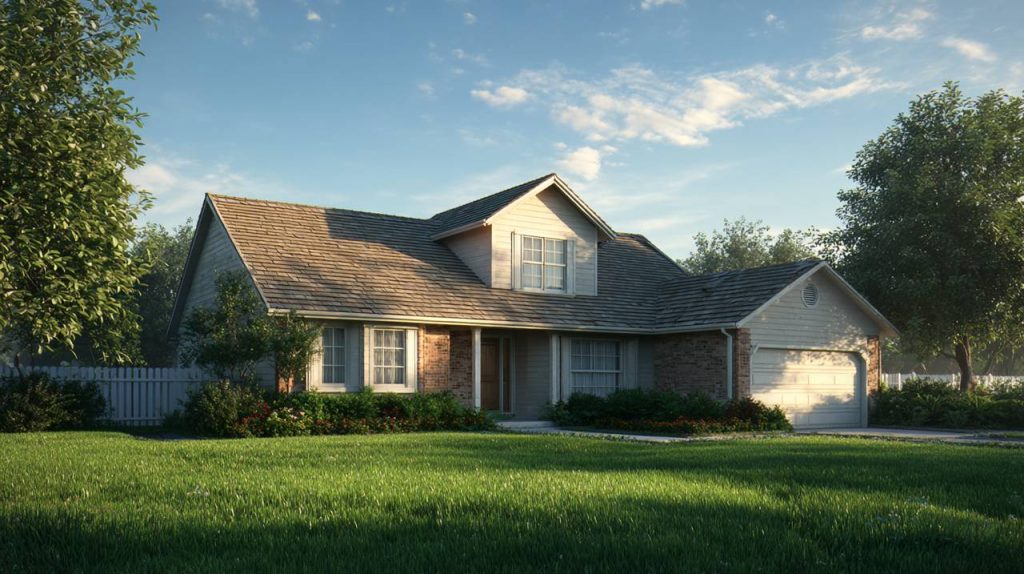Your Roof: More Than Just a Lid, It’s Your Home’s First Line of Defense
I’ve seen it countless times: homeowners view their roof as just… well, a roof. A simple cover. But trust me, that perspective is a ticking time bomb.
Think of your roof not as a hat, but as the single most critical guardian of your entire property. It’s the silent sentinel, constantly battling the elements, protecting everything you value beneath it. I once had a client who dismissed a small leak as “just a drip.” A year later, that drip had led to widespread mold, ruined family heirlooms in the attic, and a structural repair bill that dwarfed the cost of a proper roof inspection and repair. It was a stark reminder: ignorance is not bliss when it comes to your roof.
Choosing the right material isn’t just a casual decision; it’s a strategic investment. It impacts everything from your structural integrity to your monthly energy bills, and even your home’s curb appeal. With so many options out there, how do you cut through the noise and make the right call? That’s what we’re here to demystify.

The Arsenal of Options: Diving into Roofing Materials
Alright, let’s get down to the brass tacks. When it comes to roofing, you’ve got an impressive arsenal of materials at your disposal. Each one is a specialist, designed for certain battles, climates, and architectural statements. I’ve worked with them all, and each has its own story, its own strengths, and its own Achilles’ heel.
Asphalt Shingles: The Reliable Workhorse
If there’s a “default” roof out there, it’s probably asphalt shingles. They’re everywhere, and for good reason. They hit that sweet spot of cost-effectiveness and straightforward installation. Most people don’t realize they’re essentially a fiberglass mat soaked in asphalt, then sprinkled with mineral granules – a surprisingly robust combination for their price point.
Now, when considering these, remember:
- Composition: Fiberglass mat, asphalt, mineral granules.
- Types: Three-tab, architectural (laminated), and designer shingles.
- Lifespan: Typically 15 to 30 years, depending on quality and climate.
- Application: Ideal for residential homes with sloped roofs, offering a wide range of colors and styles.
I always tell clients: asphalt shingles are like a good, dependable sedan. They’ll get you where you need to go without fuss, but you need to understand their limits and what kind of road they’re best suited for.
Metal Roofing: The Modern Fortress
Metal roofs used to be just for barns, right? Not anymore. They’ve exploded in popularity, and honestly, it’s about time. Their durability is legendary, and they bring a sleek, modern aesthetic that instantly elevates a property. We’re talking steel, aluminum, copper, or even zinc, shaped into everything from classic corrugated panels to sophisticated standing seam designs.
Here’s what you should know about this formidable option:
- Materials: Steel, aluminum, copper, zinc.
- Styles: Standing seam, corrugated, metal tiles.
- Lifespan: Often 40 to 70 years or more.
- Advantages: Lightweight, fire-resistant, excellent for extreme weather, and highly recyclable.
When I see a metal roof done right, I see a homeowner who truly understands long-term value. This isn’t just a roof; it’s a statement of resilience.
Tile Roofing: Timeless Elegance with Serious Staying Power
Ah, tile roofs. Clay or concrete, they just exude a certain timeless charm, don’t they? And their longevity? Absolutely remarkable. But here’s the kicker that many overlook: they are heavy. Like, “your house needs to be built like a tank” heavy. That’s why they’re often a premium choice, and for good reason.
Consider these points before falling for their beauty:
- Materials: Clay (terracotta), concrete.
- Styles: Spanish S-tiles, flat shingles, barrel tiles.
- Lifespan: Can last 50 to 100 years or longer.
- Characteristics: Highly resistant to fire and insects, though they can be brittle under impact.
The sheer permanence of a tile roof is something truly special. It’s the kind of roof you install once and, with proper care, never think about again for generations.
Wood Shakes and Shingles: Rustic Charm, Demanding Care
There’s an undeniable allure to wood roofing. Cedar, redwood, cypress – they offer a natural, rustic aesthetic that synthetic materials simply can’t replicate. The difference between shakes (split for texture) and shingles (sawn for smoothness) is subtle but important for the final look.
But let’s be blunt about their reality:
- Materials: Cedar, redwood, cypress.
- Form: Shakes (split), shingles (sawn).
- Lifespan: Generally 20 to 40 years with proper maintenance.
- Considerations: Requires regular upkeep and is susceptible to fire without treatment.
I’ve witnessed both the beauty and the heartbreak of wood roofs. They can be absolutely stunning, but they demand a level of commitment and ongoing maintenance that not every homeowner is prepared for. Don’t underestimate the “considerations” here.
Flat Roof Systems: The Unsung Heroes of Modern Architecture
Now, for the unsung heroes, especially in commercial or modern residential design: flat roof systems. When you’ve got a low-slope or truly flat roof, you’re not just picking a material; you’re choosing a specialized membrane system designed to prevent the absolute nightmare of water pooling and leaks. This is where precision and material science truly shine.
The main players in this specialized field are:
- TPO (Thermoplastic Polyolefin): A reflective membrane known for energy efficiency.
- EPDM (Ethylene Propylene Diene Monomer): A durable synthetic rubber membrane, often called “rubber roofing.”
- PVC (Polyvinyl Chloride): A flexible, robust thermoplastic membrane.
If you’re dealing with a flat roof, your primary concern isn’t just aesthetics; it’s absolute, unwavering waterproofing. This is where you absolutely cannot cut corners.

Beyond the Basics: Performance, Suitability, and Energy Efficiency
So, you’ve got the lay of the land regarding the major material types. But knowing what they are is only half the battle. Now, we need to talk about how they perform in the real world, under the relentless assault of Mother Nature, and how they contribute to your home’s overall efficiency and look. This is where strategy truly comes into play.
Durability & Climate Adaptation: Your Roof vs. The Elements
This is where the rubber meets the road, or more accurately, where your roof meets the storm. A material’s ability to stand up to your local climate isn’t just “essential”; it’s a non-negotiable. I’ve seen too many homeowners regret choosing a beautiful but ultimately inadequate material for their region. For example, in hail-prone areas, opting for anything less than Class 4 impact-resistant materials – like certain metal roofs or reinforced asphalt shingles – is like bringing a butter knife to a gunfight. You’re just asking for trouble.
A quick breakdown of how common materials fare:
- Asphalt: Good general performance but can degrade in extreme UV exposure.
- Metal: Excels in all climates, resisting high winds and heavy snow loads.
- Tile: Offers excellent fire resistance but requires strong structural support.
- Wood: Needs treatment for fire resistance and regular maintenance.
- Flat Roofs: Focus on waterproofing and require proper drainage to prevent issues.
Remember, a roof isn’t just for sunny days. It’s for the worst day your climate can throw at it. Choose wisely.
Aesthetics & Architectural Style: The Crown Jewel of Your Home
Beyond pure function, your roof is your home’s most prominent architectural feature. It’s the crown jewel. It dictates curb appeal and sets the tone for your entire property. I’ve seen the same house transformed from bland to breathtaking just by changing the roof material and color. Each material tells a different story visually.
Here’s a snapshot of their visual signatures:
- Asphalt: Highly versatile with many colors and textures.
- Metal: Provides a sleek, modern look, complementing various designs.
- Tile: Evokes Mediterranean or Southwestern styles, adding timeless charm.
- Wood: Delivers a natural, rustic appeal.
- Flat Roofs: Offer a minimalist aesthetic, often hidden from view.
Don’t underestimate the power of aesthetics. A well-chosen roof can add significant perceived value and truly complete your home’s architectural vision.
Energy Efficiency & Sustainability: Smart Choices for Your Wallet and the Planet
This is where your roof can literally pay you back. The right roofing material can dramatically influence your building’s energy consumption, putting real money back in your pocket by slashing cooling and heating costs. It’s not just about being “green”; it’s about being smart.
Let’s break down the key factors:
- Reflectivity: Think of it like wearing light colors on a hot day. Light-colored materials and “cool roof” coatings reflect solar radiation, sending that heat back into the atmosphere instead of letting it bake your attic. This is a game-changer in warmer climates.
- Insulation: While the material itself offers limited insulation, it’s part of a larger system. A well-chosen material complements your attic insulation, contributing to overall thermal performance.
- Sustainability: This is where we look at the bigger picture. Metal roofs, for instance, are highly recyclable at the end of their incredibly long life. Some asphalt shingles even incorporate recycled content. It’s about choosing materials that are kind to the planet, not just your home.
I always encourage clients to think beyond the immediate cost and consider the long-term energy savings. That’s true value.
This is why I preach: the long-term value of a roof extends far beyond its initial sticker price. It’s about the cumulative savings from energy efficiency, the peace of mind from reduced maintenance, and the undeniable boost to your property’s overall value. It’s an investment, pure and simple.
The Bottom Line: Costs, Return, and What You’re Really Paying For
Okay, let’s talk numbers. Because no matter how beautiful or durable a roof is, the budget always comes into play. But here’s my critical piece of advice: never look at just the upfront cost. That’s a rookie mistake. You need to understand the true cost of ownership, which means factoring in long-term maintenance, potential energy savings, and, crucially, your return on investment.
Initial Installation Costs: The Sticker Shock vs. The Reality
Yes, the initial outlay is often the biggest hurdle. These figures are rough estimates, as costs fluctuate wildly based on material type, the complexity of your roofline, and local labor rates. These prices typically cover both the material and the installation.
Here’s a general guide, but please, treat these as starting points, not gospel:
- Asphalt Shingles: Economical upfront, ranging from $3 to $7 per square foot.
- Wood Shakes/Shingles: Mid-range, typically $6 to $12 per square foot.
- Metal Roofing: Higher initial investment, from $8 to $18 per square foot.
- Flat Roof Systems (TPO/EPDM/PVC): Often $5 to 15 per square foot.
- Tile Roofing: Highest initial cost, ranging from $10 to $25+ per square foot.
My biggest warning here: don’t let a low bid blind you to potential red flags. I’ve seen countless homeowners choose the cheapest option only to face shoddy workmanship, hidden fees, and premature failure. Sometimes, paying a little more upfront saves you a fortune in heartache later.
Maintenance & Life Cycle Costs: The Hidden Price Tag
This is where the “true cost” really reveals itself. A roof’s price isn’t just what you pay on day one; it’s what you pay over its entire lifespan – from initial installation, through ongoing maintenance, to its eventual, inevitable replacement. This is where a seemingly “expensive” roof can become the most economical choice.
Consider how these play out:
- Asphalt: Moderate maintenance, needing replacement every 15-30 years.
- Metal/Tile: Higher initial costs but minimal maintenance and exceptional lifespans.
- Wood: Requires substantial maintenance.
- Flat Roofs: Need regular inspections for longevity.
I’ve always told my clients: a roof isn’t a “set it and forget it” item, unless you want to invite disaster. Regular, proactive maintenance is the cheapest insurance you can buy.
Value Addition & Resale Impact: Selling Your Home, Smartly
If you’re thinking of selling your home down the line, a new roof isn’t just an expense; it’s a powerful asset. It significantly enhances curb appeal, and trust me, it’s a massive selling point. I’ve seen deals fall through because of an old, questionable roof, and I’ve seen homes fly off the market because the roof was brand new and solid.
How it impacts your home’s marketability:
- Curb Appeal: An aesthetically pleasing roof boosts visual appeal.
- Increased Home Value: High-quality materials can increase market value.
- Buyer Confidence: A new or upgraded roof reassures potential buyers.
When a buyer sees a new, high-quality roof, it communicates one thing above all else: peace of mind. And that’s priceless in a real estate transaction.
The Final Word: Your Home’s Future, Secured from Above
So, there you have it. Choosing the right roofing material is never a one-size-fits-all answer. It’s a deeply personal and nuanced decision, a delicate balance between initial outlay, long-term performance, the aesthetic you crave, and the specific climate challenges your home faces.
There’s no single “best” roof out there, only the best roof for you. It’s the one that perfectly aligns with your specific needs, your budget, and your long-term investment goals.
My strongest advice? Don’t go it alone. This isn’t a DIY project for your financial future. Always, always, consult with a qualified, reputable roofing contractor. Get multiple personalized assessments and detailed estimates. Ask the tough questions. Because ultimately, all this effort – understanding materials, weighing costs, considering aesthetics – isn’t just about shingles and metal. It’s about securing your peace of mind. It’s about protecting your biggest asset. It’s about ensuring that the guardian above your head stands strong, come what may.
💡 Frequently Asked Questions
The roof is your home's first line of defense and the single most critical guardian of your entire property, constantly battling the elements and protecting everything beneath it.
The article discusses Asphalt Shingles, Metal Roofing, Tile Roofing (clay or concrete), Wood Shakes and Shingles (cedar, redwood, cypress), and specialized Flat Roof Systems (TPO, EPDM, PVC).
The right roofing material can significantly influence a home's energy consumption. Light-colored materials and 'cool roof' coatings reflect solar radiation, reducing cooling costs, and a well-chosen material complements attic insulation for overall thermal performance.
Homeowners should consider the true cost of ownership, which includes long-term maintenance, potential energy savings, and the return on investment. A seemingly more expensive roof can be more economical over its lifespan due to minimal maintenance and exceptional durability, and it significantly boosts curb appeal and resale value.
The author strongly advises against making the decision alone. Homeowners should always consult with a qualified, reputable roofing contractor, get multiple personalized assessments, and detailed estimates to align the choice with their specific needs, budget, and long-term investment goals.






Hi, this is a comment.
To get started with moderating, editing, and deleting comments, please visit the Comments screen in the dashboard.
Commenter avatars come from Gravatar.